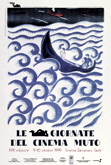
Le Giornate
del Cinema Muto
18th Pordenone
Silent Film Festival
Teatro Zancanaro, Sacile
9 - 16 October 1999
director: David Robinson
Erich von Stroheim
THE WEDDING MARCH
GREED
GREED - A RECONSTRUCTION
(Turner Classic Movies, US 1999)
Prod./dir.: Rick Schmidlin; ed.: Glenn Morgan; ed. consultant: Carol Littleton; mus.: Robert Israel; still photography: Warren Lynch; consultant: Richard Koszarski; 243', Pal Betacam SP, Turner Classic Movies.
GREED (Metro-Goldwyn, US 1924). Dir.: Erich von Stroheim; script: Erich von Stroheim, June Mathis, from McTeague by Frank Norris; ph.: Ben Reynolds, William Daniels; ed.: Frank Hull; prod. des.: Richard Day; cast: Gibson Gowland, Zasu Pitts, Jean Hersholt, Cesare Gravina, Chester Conklin, Sylvia Ashton, Dale Fuller. Didascalie inglesi/English titles.
Questa versione di Greed è innanzitutto la ricostruzione delle parti narrative perdute e non dev’essere confusa con il director’s cut. Il mio scopo è stato quello di operare in maniera filologicamente corretta puntando nello stesso tempo a dare completezza e coerenza al film e a rendenderlo fruibile cos¦ come Stroheim l’aveva concepito. Nel montare le foto di scena alla versione sopravvissuta, abbiamo aggiunto gli effetti di colore che erano indicati nella sceneggiatura di lavoro datata 31 marzo 1923 e seguito le istruzioni contenute nella stessa sceneggiatura per iridi e dissolvenze. Abbiamo cercato di creare un ritmo e di far capire esattamente la struttura e lo sviluppo narrativo originali. È una ricostruzione che dura un po’ più di 4 ore, a fronte delle nove ore e mezzo iniziali e il director’s cut finale che si avvicinava alle quattro ore e mezza [cfr. l’articolo di Richard Koszarski in Griffithiana n. 65]. La cadenza di 18 fotogrammi al secondo ci è sembrata ottimale in quanto anche le scene girate a velocità minore o maggiore per ottenere un determinato effetto scorrono con naturalezza. La colonna sonora è stata appositamente scritta da Robert Israel, tranne le musiche della scena delle nozze che erano indicate nella sceneggiatura. La collaborazione di Glenn Morgan, responsabile del montagggio, di Carol Littleton dell’ASC, consulente per il montaggio, e di Richard Koszarski, consulente per le ricerche storiche, ci ha permesso di prendere le migliori decisioni possibili. Ad esempio, tre sono le fonti delle didascalie. Delle 633 didascalie indicate nella sceneggiatura ne abbiamo utilizzate circa 600. A queste sono state aggiunte alcune citazioni dal romanzo di Frank Norris McTeague più alcune note esplicative ricavate sceneggiatura. In tal modo è stata chiarito lo svolgimento narrativa originale. Con questa ricostruzione abbiamo inteso raggiungere il pubblico più vasto possibile attraverso un mezzo commerciale come la televisione, la quale ci ha garantito i finanziamenti per l'operazione. Ma siamo sempre stati consapevoli del suo possibile utilizzo per fini di ricerca e di studio. Riteniamo infatti che conoscere meglio quello che doveva essere lo sviluppo narrativo del film aiuti, sia gli storici che il grande pubblico, a comprendere meglio un'opera la cui perdita è, a mio avviso, una delle più gravi della storia del cinema. - Rick Schmidlin, produttore
This version of Greed is primarily a reconstruction of the lost narrative structure, and should not be regarded as an attempt to recreate a "director’s cut". My aim has to be to keep the work academically correct and at the same time to ensure that the original narrative is completely coherent and as accessible as Erich von Stroheim intended. In intercutting still production photographs with the surviving elements of the film, we have added original colour effects that were specified in a continuity screenplay dated 31 March 1923, and followed instructions in the same screenplay for irises, barn-doors, fade-ins and fade-outs. We have sought to give a rhythm, and to convey a proper understanding of von Stroheim’s structure and story development.
This version runs a little over four hours, so that we can guess the story content falls somewhere between that of the nine-and-a-half hour version and the final director’s cut of approximately four and a half hours. A projection speed of 18 frames per second has seemed to be the optimum, allowing those scenes that were originally over- or under-cranked for special effect to flow naturally. The music is an original score by Robert Israel, except for the composition used in the wedding sequence, which was specifically called for by the screenplay.
A continuing collaboration with the talents of Glenn Morgan as head editor, Carol Littleton ASC as editorial consultant and Richard Koszarski as historical consultant enabled us to seek the best possible editorial procedures. As an example, titles were drawn from three sources. The screenplay called for 633 titles, of which approximately 600 were used. Second, some additional explanatory quotations from Frank Norris’s original novel "McTeague" were required. Finally we added some explanatory titles extracted from the directions of the screenplay. In this way we were able fully to clarify the original narrative.
The intention of this reconstruction was to reach the widest audience possible - principally through television, since that was the source of our funding. But at the same time we remained conscious of its future use for academic study, discussion and analytical dissection. Both types of user, academics as well as general audiences, had, we felt, the same need for the story to be told as faithfully as possible, in order to enhance understanding of a work whose loss, I believe, is the greatest in cinema history.
Rick Schmidlin, Reconstruction Producer